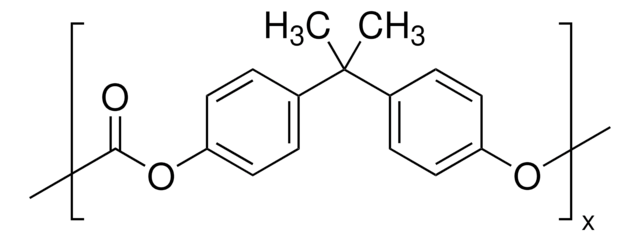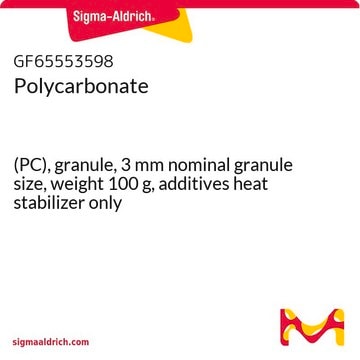435139
Poly(Bisphenol A carbonate)
melt index 10-12 g/10 min (300°C/1.2kg)
Synonym(s):
2,2-Bis(4-hydroxyphenyl)propane-carbonic acid copolymer, Bisphenol A carbonate polymer, Bisphenol A polycarbonate, Poly(bisphenol A carbonate), Poly(dian carbonate)
About This Item
Recommended Products
form
pellets
Quality Level
melt index
10-12 g/10 min (300°C/1.2kg)
impact strength
801 J/m (Izod, ASTM D 256, 22.7 °C)
dielectric constant
2.96, 1 MHz (ASTM D 150)
hardness
118 (Rockwell R, ASTM D 785)
refractive index
n20/D 1.586
transition temp
softening point 154 °C (Vicat, rate B, ASTM D 1525)
density
1.2 g/mL at 25 °C (lit.)
SMILES string
CC(C)(c1ccc(O)cc1)c2ccc(O)cc2
InChI
1S/C15H16O2.CH2O3/c1-15(2,11-3-7-13(16)8-4-11)12-5-9-14(17)10-6-12;2-1(3)4/h3-10,16-17H,1-2H3;(H2,2,3,4)
InChI key
XSXWYGABGYBZRM-UHFFFAOYSA-N
Gene Information
mouse ... Esr1(13982)
rat ... Ar(24208)
Looking for similar products? Visit Product Comparison Guide
Related Categories
General description
Storage Class Code
11 - Combustible Solids
WGK
WGK 3
Flash Point(F)
Not applicable
Flash Point(C)
Not applicable
Personal Protective Equipment
Choose from one of the most recent versions:
Already Own This Product?
Find documentation for the products that you have recently purchased in the Document Library.
Customers Also Viewed
Our team of scientists has experience in all areas of research including Life Science, Material Science, Chemical Synthesis, Chromatography, Analytical and many others.
Contact Technical Service









